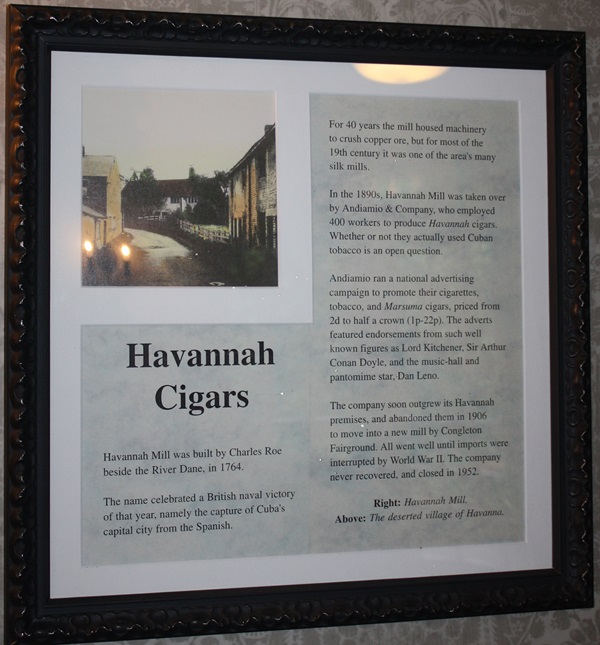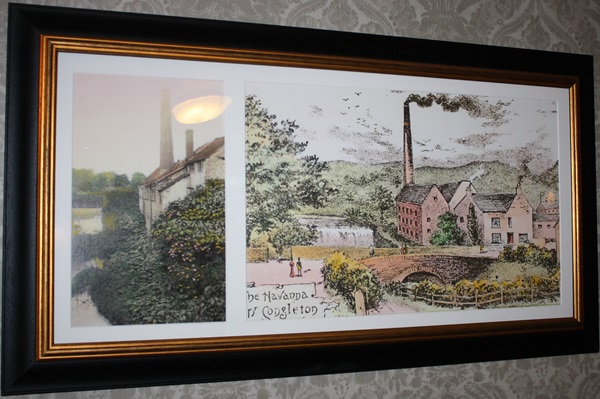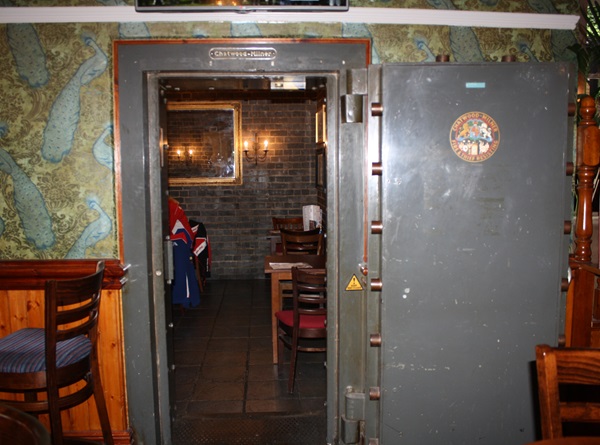This distinctive Tudor-style building has long been a feature of Swan Bank. Until 1995, it had been a bank for well over 100 years, beginning with the Manchester and Liverpool Banking Company, in 1876. Previously, the building had been the Moreton Arms, named after a powerful family – local landowners for centuries. They lived nearby at Little Moreton Hall – one of the finest Elizabethan timber-framed buildings in the country.
Prints and text about The Counting House.

The text reads: This J D Wetherspoon pub on Swan Bank occupies a former branch of the Natwest Bank. It had been a bank for 120 years, having been used from 1876 by the Manchester & Liverpool District Banking Company.
The bank paid £10,000 to buy and adapt the premises of a hotel, the Moreton Arms, named after the family who had been local landowners for some seven centuries. A previous Moreton Arms, n part of the same site, (another part being occupied by Starkey’s shoe shop) was a coaching inn. The nearby Lion & Swan, another coaching inn, is said to have given its name to Swan Bank, previously known as Clay Bank.
A fountain was erected outside this building in 1887 to commemorate Queen Victoria’s Golden Jubilee. The fountain was a popular rendezvous until it was moved to Mill Green in 1936/
Right: The Counting House site, c1900
Left: The Fountain.
A print and text about Thomas Telford and the Macclesfield Canal.

The text reads: The Macclesfield Canal, linking Congleton with Kidsgrove and Marple, was begun in 1828, and took three years to complete. Designed by the famous civil engineer Thomas Telford, the Canal’s main local wharf was on Canal Road.
However, its useful life was short lived, as in 1847 it was superseded by the Stoke to Manchester railway line.
One railway project which did not materialise was the proposed main line between Birmingham and Manchester via Stone, Congleton and Eaton. This would have transformed Congleton into a major railway junction.
In the event, the uneven terrain frustrated the scheme, although the promoters delivered huge loads of bricks, intended for a viaduct over the Dane. The bricks are said to have been used to build Antrobus Street.
Right: Thomas Telford.
An illustration and text about churches and schools in Congleton.

The text reads: Congleton was once part of the parish of Astbury, where the parish Church was situated. From the 1300s, the town had two chapels, Higher and Lower. By the 16th century, the Lower, or Bridge, Chapel was in use as a bell-foundry, but it was demolished in 1814.
In 1740, the High Chapel as rebuilt as St Peter’s Church. Part of the chapel tower was retained, with bells locally recast in 1720. The interior was fitted out with massive woodwork, and a Jacobean pulpit.
A curious custom, said to represent St Peter in chains, but probably of pagan origin, used to be carried out by minor church official in Congleton. Wearing belts with bells on, they danced around the town on St peter’s Eve (August 11). The custom was later taken over by chimney sweeps, to celebrate their holiday. One belt survived and is kept in the Town Hall.
The parish hall was built in 1814 to house Congleton’s Grammar School, established during the 16th century. Its masters, paid £16 per year by the Corporation, often doubled as ministers at the church. In the early 18th century, there were around 100 pupils, who were forbidden to speak anything but Latin or Greek on the premises. The school was closed in 1910.
Above: Interior of St Peter’s, c1847.
Illustrations and text about Little Moreton Hall.

The text reads: The nearby Hall is probably the country’s best known example of a medieval timber-framed building. The house was begun around 1440, and has been altered very little since 1600.
Little Moreton Hall’s most striking feature is its black and white patterning. However, the blackening of the exposed wood is unlikely to be original, and medieval plasterwork was probably never a dazzling white.
The original great hall was overshadowed by John Moreton’s south wing, with its long second-floor gallery. This feature, fashionable from the 1570s, was once thought to be a later addition, but was probably an alteration during the construction of the wing.
Since 1938, Little Moreton Hall has been owned by the National Trust. During repairs and restoration, ancient wall-paintings were discovered behind wood panelling, and a traditional garden was re-established.
Right: Little Moreton Hall, 1835
Left: Interior of the Chapel.
A print and text about the silk industry.

The text reads: The secret of silk production is said to have been brought to Europe from China by a Jesuit priest. Silk-weaving reached Britain in the 16th century, becoming widespread with the arrival of French refugees fleeing from religious persecution.
Congleton’s first silk mill was built in 1753 by John Clayton and Nathaniel Pattison. The Old Mill was powered by a 20-foot water-wheel designed by James Brindley, one of the greatest canal-engineers of his time.
The town soon had several silk mills, all powered by the Howty or the Dane. Steam power was introduced in 1801 by Thomas Slate. More mills were built, and the trade prospered until the 1820s, when changes in fashion and an increase in imports brought a slump.
Free Trade treaties in the 1860s set the industry, which then had 5,000 local employees, on a downward path from which it never recovered.
Right: James Brindley.
A print and text about Havannah Cigars.


The text reads: Havannah Mill was built by Charles Roe beside the River Dane, in 1764.
The name celebrated a British naval victory of that year, namely the capture of Cuba’s capital city from the Spanish.
For 40 years the mill housed machinery to crush copper ore, but for most of the 19th century it was one of the area’s many silk mills.
In the 1890s, Havannah Mill was taken over by Andiamio & Company, who employed 400 workers to produce Havannah cigars. Whether or not they actually used Cuban tobacco is an open question.
Andiamio ran a national advertising campaign to promote their cigarettes, tobacco, and Marsuma cigars, priced from 2d to half a crown (1p-22p). The adverts featured endorsements from such well-known figures as Lord Kitchener, Sir Arthur Conan Doyle, and the music-hall and pantomime star, Dan Leno.
The company soon outgrew its Havannah premises, and abandoned them in 1906 to move into a new mill by Congleton Fairground. All went well until imports were interrupted by World War II. The company never recovered, and closed in 1962.
Right: Havannah Mill
Above: The deserted village of Havannah.
A photograph and text about George Harold Eardley VC.

The text reads: George Harold Eardley VC (born 6 May 1912 in the town of Congleton) was a recipient of the Victoria Cross, the highest and most prestigious award for gallantry in the face of the enemy that can be awarded to British and Commonwealth forces.
A photograph of Bridge Street, Congleton c1950.

A photograph of Lawton Street, Congleton c1910.

A photograph of Lawton Street and High Street, Congleton c1920.

A photograph of High Street, Congleton c1921.

A photograph of the canal, Congleton c1908.

A photograph of Mill Street, Congleton c1907.

There is still a Chatwood–Milner bank vault inside the pub.
It is now used as a dining area.



External photograph of the building – main entrance.

Extract from Wetherspoon News Winter 2018.

If you have information on the history of this pub, then we’d like you to share it with us. Please e-mail all information to: pubhistories@jdwetherspoon.co.uk